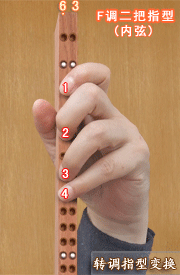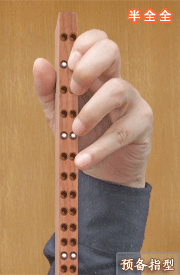Detailed graphic teaching of erhu-modulated fingering and aerial fingering
When beginners press the sound on the erhu, the common finger position is incorrect, and it is difficult to press the sound accurately. The most important one is the left-hand shape, especially the irregular finger shape. The shape of the left hand directly affects the basic movements of the fingers, such as up and down, forward and backward stretching, etc., which directly affects the pitch. The practice of hand shape mainly includes the arrangement of the four fingers of the left hand, the state of the joints of the hand, the position of the thumb and the posture of the wrist. Today we will talk about the practice methods of erhu transfer fingering and air fingering.
Erhu transposition finger shape transformation
The following is the change in the left finger shape and frame in the modulation. The example only involves the main and most common four keys (D key, G key, F key, B flat key), and the transformation of other keys is similar.

D-G major transition
The picture on the left shows the conversion of D major and G major. In the exercise, pay attention to the difference in the position of the outer string fingers between the two keys. In the key of G(5 2), 1-2 means close together; in D(1 5), 2-3 means close together. This is the main difference between the two tones.

F-bB major conversion
The picture shows the conversion of F major and B flat major. In the exercise, pay attention to the difference in the position of the outer string fingers between the two keys.

Erhu Air Finger
The so-called "air finger type" proposed here refers to a position where the fingers are in a state of not pressing the sound, such as the index finger or the little finger pressing down, while the other fingers are not pressing the sound or the four fingers are not pressing the sound. This exercise is very useful for the formation of the correct hand shape in the process of changing the handle, and it is very beneficial to stabilize the left hand shape. Practicing on the phoneme stick can visually observe the finger spacing, see the following diagrams:

"Half-full" (122) pre-press and real-press
When pre-pressing "air", try to keep 1-2 fingers close, 2-3 fingers apart, and 3-4 fingers apart. This exercise is often used in the diatonic scales of the following keys.
As in the first position:
..C major (2 6 strings) inner and outer strings;
..G major (5 2 strings) outer strings;
..F major (6 3rd) internal strings.
As in the third position:
..B-flat major (3 7th string) outer strings;
..E-flat major (7 #4 string) inner and outer strings.

Erhu's Air Fingering
"Full half full" (212) pre-press and real-press
When pre-pressing "air", try to keep 2-3 fingers close, 1-2 fingers apart, and 3-4 fingers apart. This exercise is often used in the diatonic scales of the following keys.
As in the first position:
..D major (1 5 strings) inner and outer strings;
..G major (5 2 strings) internal strings:
..A major (4 1 string) outer strings.

The picture on the left shows the change of the air finger shape before and after the first position of the outer string is changed to the third position
1. Before changing the handle (the first position), it is a kind of "semi-full" finger type (1-2 refers to a semitone relationship, 2-3 refers to a whole tone relationship), but 2-3-4 refers to a whole tone relationship. The three fingers are not pressed, and they are in the "air" state.
2. After changing the handle (the third position), it is a kind of "full full half" finger type.
In the key of G major (5 2 strings) the outer strings are frequently used fingerings.
Note: During practice, you can lift your index finger to practice, or you can press another finger, such as pressing the little finger, lift 123 fingers to practice.
 渝公网安备 50010702504639号
渝公网安备 50010702504639号